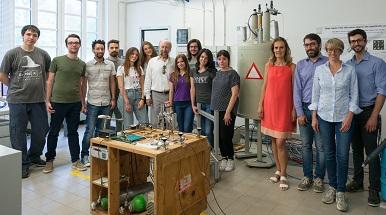Generation of nanospaces for polymerization and gas capture

The preparation and characterization of novel nanostructured materials showing permanent porosity or including polymers in supramolecular architectures are the main target of our research group. The effort for designing suitable nanospaces and optimizing extended interfaces enabled the fabrication of materials containing gases and polymers endowed with unusual properties and controlled morphologies. The link between structure and properties is provided by a detailed characterization by magic angle spinning nuclear magnetic resonance (MAS NMR) and wide-line NMR. Laboratories for synthesis and NMR spectroscopy, dedicated to the preparation and the characterization of solid materials, are available.
Current research projects
The current research topics are dedicated to the general themes of confinement of gases and macromolecules to galleries and nanochannels of various cross-sections (0.5 up to 4.5 nm). Nanoporous materials are synthesized and exploited for this sake, realizing absorption of gases and polymerization in the confined state.
The matrices encompass molecular crystals (including dipeptides), metal organic frameworks (MOFs), hybrid mesoporous structures, hyper-crosslinked polymers and porous organic frameworks. The matrices, showing extended interactive areas (1000 - 5000 m2/g), form intimate host-guest adducts, realizing extraordinarily robust organic materials and solids containing molecular-rotors, whose dynamics is regulated by species diffusing-in.
The study of reactivity and interactions of the guests included in nanometric vessels and supramolecular architectures encompasses also morphological replicas by polymerization and thermal transformation of included polymers to conjugated polymers or carbon nanofibers. Diffusion processes of gases into the porous materials and the direct detection of gases diffusing into solids is performed by MAS and hyperpolarized NMR (129Xe, CO2, CH4 and H2).
Research Team
Prof. Silvia Bracco
Dr. Charl Xavier Bezuidenhout
Prof. Piero Sozzani
Research Lab
Laboratory of Solid State NMR - U5 Building, Ground Floor, Room T067A/B
Laboratory of Characterization of Porous Nanostructures - U5 Building, Ground Floor, Room T066
Laboratory of Synthesis and Characterization of Polymers - U5 Building, Ground Floor, Room T032 (Section B)
Facilities
- Bruker NEO_300 MHz NMR spectrometer with superconducting wide bore magnet of 7.05 T dedicated to solid state, fully equipped with CP-MAS magic angle spinning probes to work up to 15 kHz and several heads for wide-line spectroscopy, including deuterium. Bruker Avance III_600 MHz NMR spectrometer equipped with cryoprobe, HR MAS and CP MAS 35 kHz spinning-speed CP-MAS probes. High vacuum (10-9 torr) pumps and equipment for hyperpolarized Xenon spectroscopy (laser-excited NMR)
- Gravimetric gas absorber (CO2) at different temperatures and pressures up to 20 bar (IGA)
- Microcalorimeter (Setaram μDSC7) coupled to volumetric adsorption absorber (Micromeritics ASAP 2050) for measurement of enthalpy of gas-matrix interaction at controlled gas loading
- Differential Scanning Calorimeter (STARe DSC, Mettler Toledo)
- Schlenk Lines, Solvents Dry System
- Gel Permeation Chromatography (GPC, Waters) and Dynamic Mechanical Analyzer (DMA, Perkin Elmer) for polymers characterization
The group has also access to:
- X-ray Diffractometers of crystalline powders (PXRD, SMARTLAB Rigaku and MINIFLEX Rigaku instrumentations)
- Thermogravimetric Analysis (TGA, Mettler Toledo)
- Centre of Electronic Microscopy of University of Milano-Bicocca